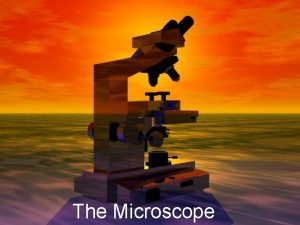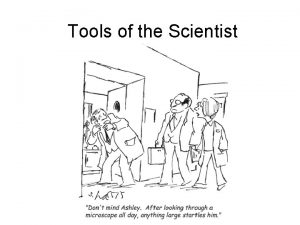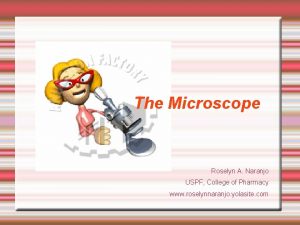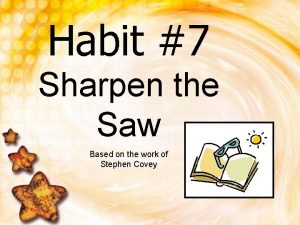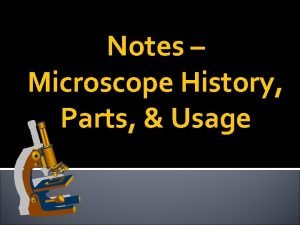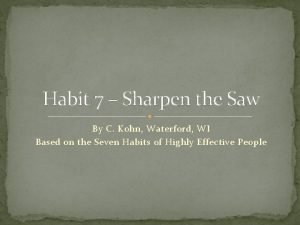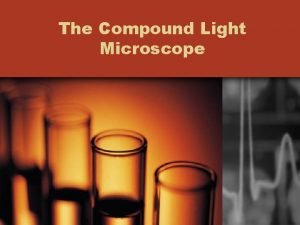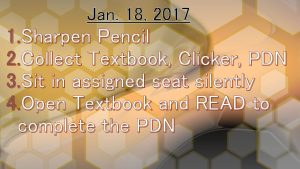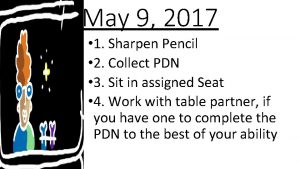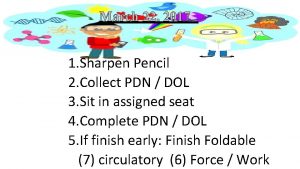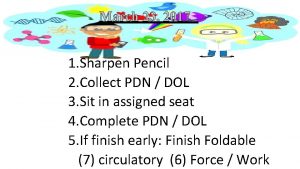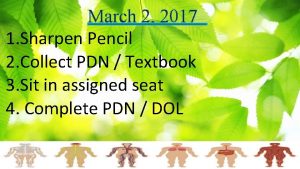Jan 19 2017 1 Sharpen Pencil 2 Collect











- Slides: 11

Jan. 19, 2017 1. Sharpen Pencil 2. Collect Textbook, PDN 3. Sit in assigned seat silently 4. Read and FOLLOW directions on PDN

th 7 Grade TEK • TEK: 7. 12 F Recognize that according to cell theory all organisms are composed of cells and cells carry on similar functions.

th 6 Grade TEK • TEK 6. 12 (12) Organisms and environments. The student knows all organisms are classified into Domains and Kingdoms. Organisms within these taxonomic groups share similar characteristics which allow them to interact with the living and nonliving parts of their ecosystem. (A) understand that all organisms are composed of one or more cells; (B) recognize that the presence of a nucleus determines whether a cell is prokaryotic or eukaryotic;

th 7 Grade LO • LO: We will create a time line to show the sequence of events in the creation of the cell theory. TEK: 7. 12 F Recognize that according to cell theory all organisms are composed of cells and cells carry on similar functions.

th 7 Grade DOL • DOL: I will complete written STAAR type assessment questions over the cell theory.

7 th Grade PDN / DOL Quiz • Teacher will go over each question with class as they click in their answers.

7 th Grade Time Line of the Cell Theory • 1: Fold manila paper going the tall and skinny / hotdog direction (see teacher for example • 2: Cut the paper in half along the long crease • 3: tape the two half sheets together to form 1 long line of paper (see teacher for example) • 4: fold the one long sheet in half going the long directions ( see teacher for example) • 5: Start time line with Robert Hooke, end with a famous discovery about cells in the last 15 years. • Date • What he is famous for • Illustrate

Ro t r be Fam Example to get started with… e k o o 1__ - 2__ year gap H _ ___ _ ___ r__ o f us Due to __________ o 16__ o t n A 18__ __ _ 16__ __ e _ _ k _ _ o ___ _ h _ _ n r__ e o f w us o u m e Fa e L an V n

th 6 Grade LO LO: We will investigate what a prokaryotic cell and a eukaryotic cell is through completion of pg. 2 -6 in prokaryotic / eukaryotic book. • TEK: 6. 12 A/B (A) understand that all organisms are composed of one or more cells; (B) recognize that the presence of a nucleus determines whether a cell is prokaryotic or eukaryotic

th 6 Grade DOL • DOL: I will complete written STARR type questions over prokaryotic and eukaryotic cells.

6 th Grade PDN 6 th Grd: Cell pg. 598 -599 • Directions: Collect Textbook, open to page 598, READ the pages listed to complete the chart below. Use the word bank to write in the correct answers. If a letter has a number, don’t forget to write the correct number also. • You have 10 minutes to complete this before we click it into “all in learning” Letter Word Bank # Question or Statement Answer Choice A 1 Cell membrane 1 E 1 B 1 organelle Cell membranes. Cytoplasm, organelles, and DNA can be found in every type of ______. C 1 cytoplasm 2 A 1 DNA What is the protective layer that covers a cell’s surface and acts a barrier that controls what gets in and what gets out called? E 1 cell 3 What is the fluid that all the cell organelles are contained in called? C 1 A 2 Membranebound 4 What is a small body in a cell’s cytoplasm that perform special functions called? B 1 5 What is found in the nucleus of the cell and controls our genetic material called? D 1 B 2 prokaryote 6 The way cells store their DNA is the main ______ between two cell types. D 2 C 2 multicellular 7 What is a single celled organism that does not have a nucleus called? B 2 D 2 difference 8 Prokaryotic cells do not have _______ organelles. A 2 E 2 eukaryote 9 What type of cells have a nucleus where their DNA is stored? E 2 10 Most eukaryotes are ________. C 2
 Parts of janssen microscope
Parts of janssen microscope Maturity continuum
Maturity continuum Once upon a time woodcutter story
Once upon a time woodcutter story Moves the body tube slightly to sharpen the image
Moves the body tube slightly to sharpen the image What does sharpen the saw mean
What does sharpen the saw mean Moves the stage slightly to sharpen the image
Moves the stage slightly to sharpen the image 4 dimensions of sharpen the saw
4 dimensions of sharpen the saw How to sharpen your soul
How to sharpen your soul History of the microscope
History of the microscope Sharpen the saw meaning
Sharpen the saw meaning Moves the stage slightly to sharpen the image
Moves the stage slightly to sharpen the image Sharpen the saw heart
Sharpen the saw heart
